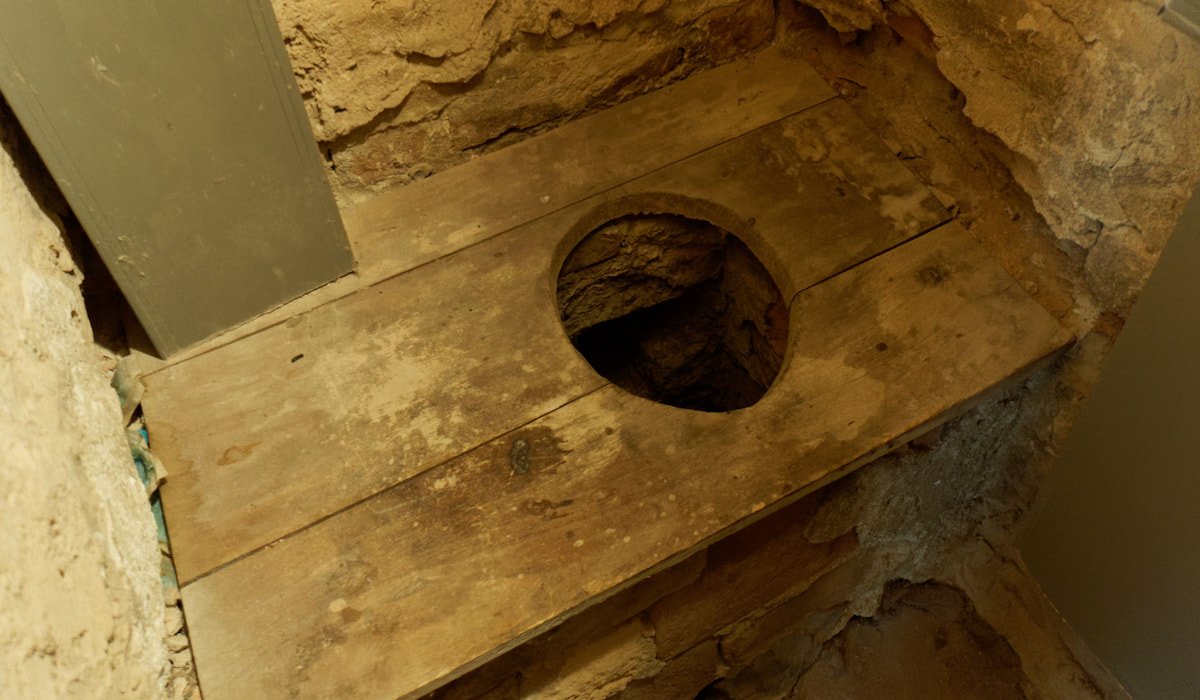
Medieval castles evoke images of grandeur, fortitude, and the tales of knights and royalty.
However, amidst the tapestries and stone walls, there lies an intriguing aspect of daily life in these fortified structures that is often overlooked—the toilets.
The sanitation practices of medieval castles offer a unique window into the past, shedding light on the complexities of life within their walls.
In this article, we will delve into the captivating world of medieval castle toilets, exploring their designs, challenges, and the cultural significance they held during that era.
The Castle’s Necessity: The Emergence of Castle Toilets
As castles evolved from mere military strongholds to multifunctional residences, the need for designated areas for bodily functions became increasingly apparent.
The emergence of castle toilets, or “privies,” marked an essential milestone in castle architecture and reflected the growing emphasis on comfort and hygiene.
These structures, often positioned in discreet locations within the castle walls, provided a means of convenience and cleanliness for the castle inhabitants, distinguishing them from the rugged conditions and lack of sanitation prevalent in earlier fortifications.
The introduction of castle toilets not only improved the overall living conditions but also symbolized the refinement and sophistication of the castle lifestyle during that era.
- Read also: Who Invented The Toilet Paper
- Read also: Who Invented the Flush Toilet
The Design of Medieval Castle Toilets
Holes in the wall: The “Garderobes”
Medieval castle toilets, often referred to as “garderobes,” were ingeniously designed.
Typically located in the castle walls, these openings allowed waste to drop into a chute or directly into the moat surrounding the castle.
The strategic positioning offered an added layer of defense, as the foul odor helped deter potential invaders.
Keep it fresh: The importance of air circulation
To minimize the stench within the castle, architects incorporated ingenious ventilation systems into the design.
These included openings and shafts that facilitated airflow, allowing unpleasant odors to dissipate and fresh air to circulate.
Waste Disposal: The chute and the moat
Waste from the garderobes would slide down chutes or pipes and into the castle’s outer moat.
The moat acted as a natural means of waste disposal, preventing the accumulation of refuse within the castle walls.
Toilet Etiquette in Medieval Castles
Privacy matters: The struggle for seclusion
Privacy was a coveted luxury even in medieval times. Castle toilets posed a challenge in this regard, as they were often located in communal areas.
To address this, some toilets were shielded with wooden or cloth curtains, offering a semblance of privacy.
Castle servants and privy duties
Castle servants were responsible for maintaining the toilets, ensuring they remained clean and functional.
The job of the “gong farmer,” a specialized servant, involved removing waste from the chutes and disposing of it outside the castle walls.
Taboos and superstitions
Medieval culture often associated toilets with taboos and superstitions.
Some believed that disposing of waste could expose personal information to enemies or evil spirits.
To counter this, some castles employed deception, such as using false chutes, to mislead potential adversaries.

The Evolution of Castle Toilets
From basic necessity to architectural innovation
As castles advanced in design, so did their toilets.
While early castle toilets were practical and functional, later constructions witnessed architectural innovations that improved comfort and convenience.
Medieval plumbing and innovations
Advancements in plumbing and engineering during the late medieval period brought improved water-based sanitation systems to castles. Water closets and flushing mechanisms began to replace the traditional chutes.
The lavish “privy chambers” of nobility
Nobility in grand castles enjoyed more sophisticated “privy chambers.”
These spaces were equipped with ornate seats and embellishments, catering to the luxurious tastes of the upper echelons.
Challenges and Hygiene Issues
Odor control and sanitation struggles
Maintaining a pleasant environment in and around the castle toilets posed significant challenges.
Given the limited ventilation and confined spaces, efforts to control odors demanded innovative solutions.
One such approach involved the utilization of aromatic substances, carefully selected herbs, and fragrant flowers, strategically placed to counteract any unpleasant smells.
These natural scents not only improved the overall atmosphere but also added a touch of sophistication to the lavatory experience, ensuring that guests were met with a pleasant and refreshing ambiance.
Health risks and the spread of disease
In defiance of manifold endeavors to assuage matters of sanitation, inclusive of the adoption of rudimentary waste disposal mechanisms, the dearth of adequate infrastructure and the restricted comprehension of hygiene during the medieval epoch instigated considerable jeopardy to individuals and communities alike.
The accrual of waste within the moat, serving as the principal repository, not merely engendered a distressing milieu for habitation, but also furnished a breeding ground for bacteria and other pathogens, thereby fomenting the unrestrained dissemination of maladies and epidemics amid the populace.
Medieval Toilets vs. Modern Bathrooms
Comparing comfort and convenience
Modern bathrooms have revolutionized sanitation practices, offering unparalleled comfort and convenience.
With their stylish designs and innovative features, they have truly transformed the way we experience personal hygiene.
Gone are the days of primitive, unsanitary medieval toilets.
Instead, we now enjoy sophisticated fixtures, such as smart toilets with heated seats, motion-activated faucets, and luxurious rainfall showers.
Technological advancements
The advent of plumbing and advanced waste management systems, along with the availability of running water and efficient waste disposal, has drastically improved modern bathrooms.
These advancements have revolutionized sanitation practices, ensuring better hygiene and convenience for individuals.
With the seamless integration of these technologies, modern bathrooms have become more comfortable and functional, providing a refreshing and relaxing experience for users.
Privacy and modern toilet culture
In modern bathroom design, privacy is a significant focus.
Individual stalls and enclosed spaces are meticulously designed to provide a sense of complete seclusion, allowing individuals to enjoy their personal space undisturbed.
This cultural shift towards privacy stands in stark contrast to the communal nature of medieval castle toilets, where a sense of shared experience was the norm.
This evolution in bathroom design reflects our changing needs and desires for personal comfort and privacy in today’s society.
Toilets as Historical Artifacts
Archaeological finds and historical insights
Archaeological excavations have unearthed remnants of medieval toilets, providing valuable insights into medieval life. These findings contribute to our understanding of medieval architecture and lifestyle.
Preservation efforts and museum exhibits
Efforts are underway to preserve castle toilets as historical artifacts. Some castles now feature museum exhibits that showcase the toilets’ design and role in medieval society.
Toilets in medieval literature and art
Medieval literature and art occasionally reference toilets, offering glimpses into the cultural significance and perceptions surrounding these structures.
- Read also: 5 Famous Women of the Middle Ages
- Read also: Feudalism in Medieval Japan
Conclusion
The study of toilets in medieval castles unveils a lesser-explored aspect of history that speaks volumes about the daily lives and challenges faced by the castle inhabitants.
From rudimentary garderobes to lavishly designed privy chambers, these structures reflect the evolution of architecture, hygiene, and cultural beliefs.
The toilets of medieval castles serve as a fascinating reminder of the ingenuity and complexity of life in a bygone era.
FAQs
Medieval castle toilets, also known as “garderobes,” were openings in the castle walls that allowed waste to drop into a chute or directly into the castle’s moat.
Early medieval castle toilets did not have running water. However, later advancements introduced water closets and flushing mechanisms in some castles.
Privacy was limited in medieval castle toilets, which were often located in communal areas. Some toilets had wooden or cloth curtains for a semblance of privacy.
Medieval castle toilets typically did not have doors. They were often open or shielded with curtains for privacy.
Castle toilets were used by all inhabitants, including the nobility, servants, and other residents of the castle.



